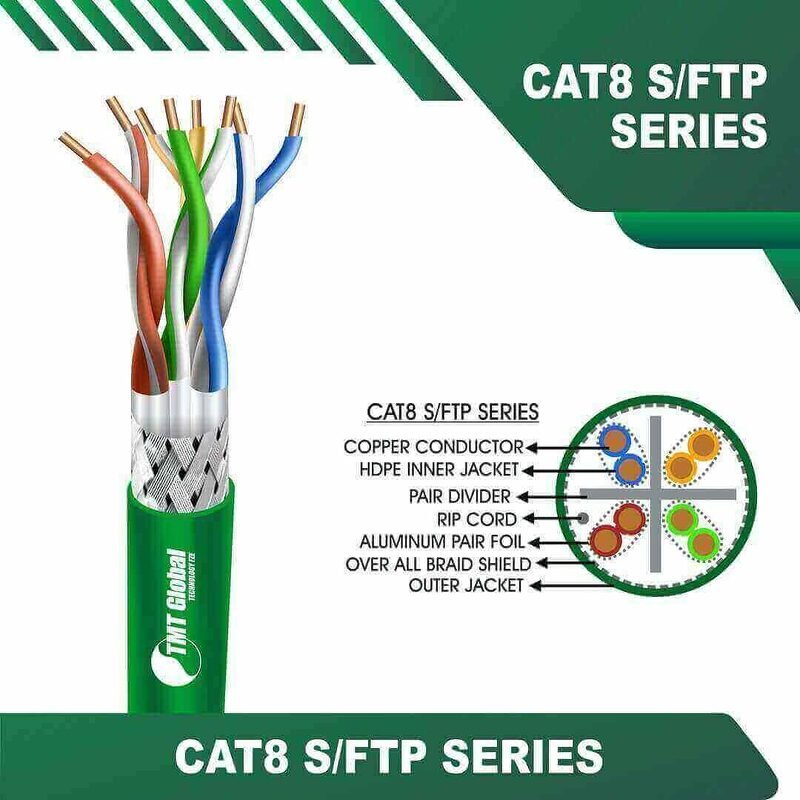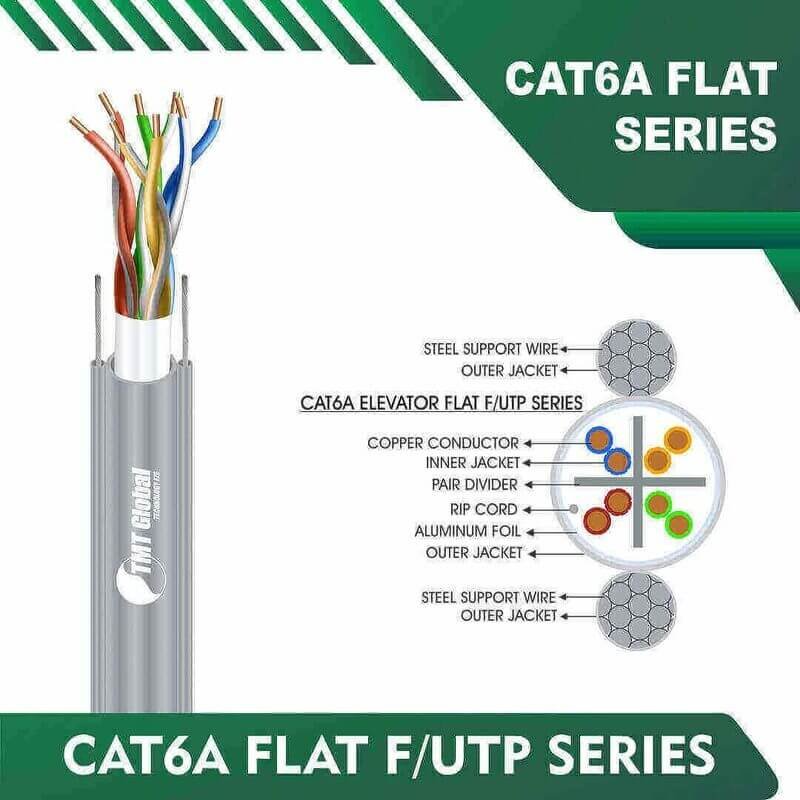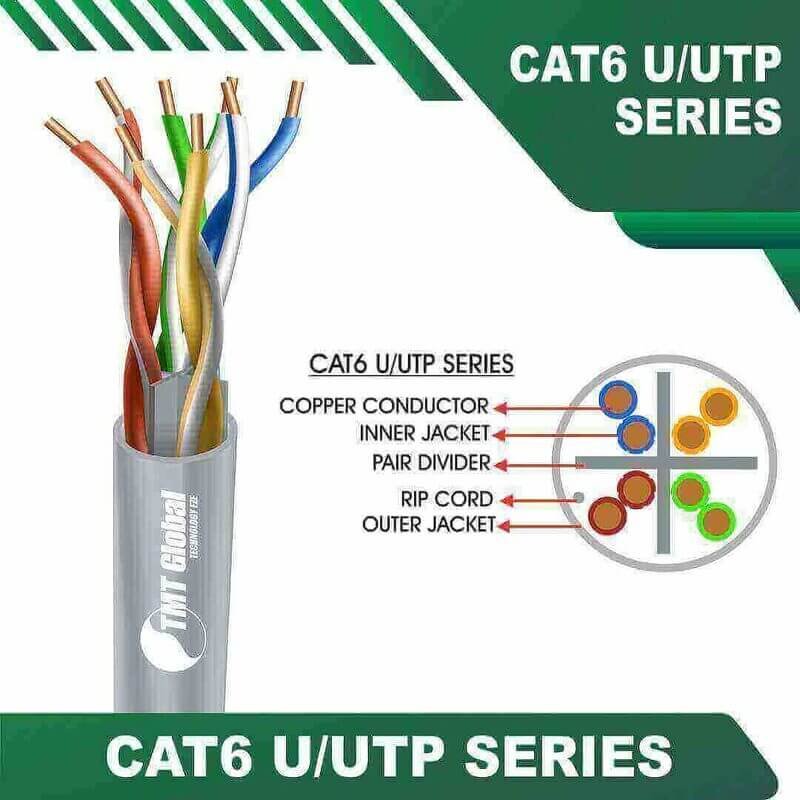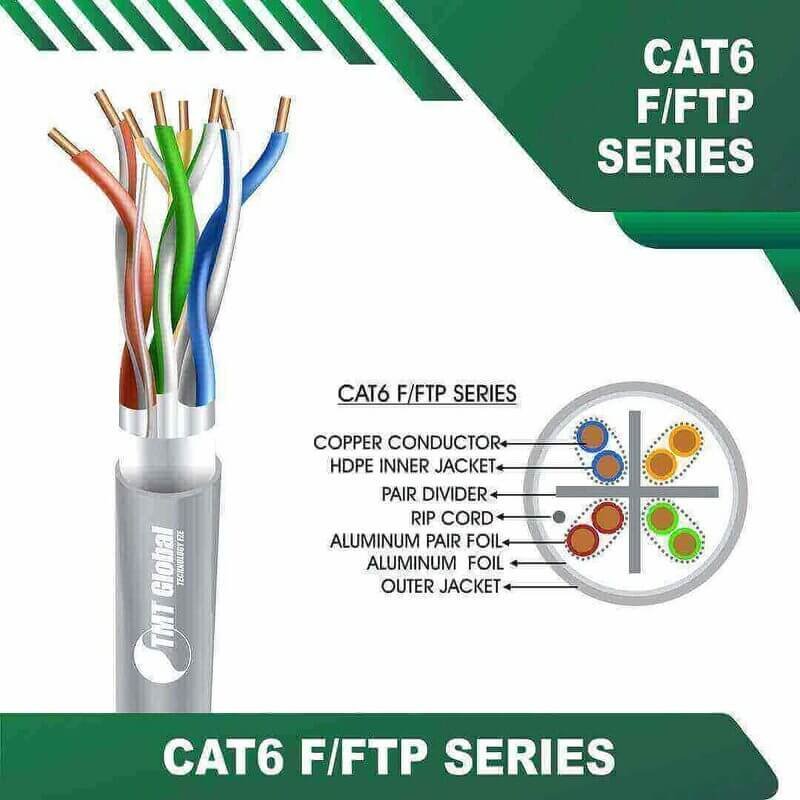Understanding Ethernet Cable Colors: Insights from ELV Solutions Provided by Al Mazrooei Security Systems in the UAE under TMT Global

Introduction to Ethernet Cables
Ethernet cables are fundamental components in modern networking, serving as the primary means of connecting devices within Local Area Networks (LAN). These cables facilitate data transmission between computers, routers, switches, and other networking equipment, enabling seamless communication and resource sharing. Since their inception in the 1970s, Ethernet technology has evolved significantly, leading to various types of cables optimized for different networking needs.Ethernet Cable Colors
The evolution of Ethernet began with the original coaxial cable, which was later replaced by twisted pair cables, greatly enhancing performance and reducing interference. Currently, there are several categories of Ethernet cables, including CAT5, CAT5e, CAT6, CAT6a, and CAT7. Each category is designed to support different speeds and bandwidth, allowing for improved data transfer rates. For instance, CAT6 cables can handle speeds up to 10 Gbps over short distances, showcasing the advancements in Ethernet technology.






Color-coding in Ethernet cables serves several important purposes. Primarily, it aids in identifying the different wires within a cable, facilitating proper connections and minimizing the risk of errors during installation. For example, the most common color-coding scheme involves pairing specific colors for twisted pairs, such as blue with white and orange with white. This standardization helps technicians and network administrators maintain organized networks and troubleshoot issues effectively.
Understanding Ethernet cables and their color-coding is crucial for anyone involved in networking, as it enables proper installation and optimization of network performance. With the increasing demand for high-speed internet and reliable connectivity, the role of Ethernet cables continues to be vital in various environments, from residential setups to sophisticated commercial systems.
The Importance of Cable Color-Coding
Color-coding in Ethernet cables plays a crucial role in modern networking systems. Each color serves a specific purpose, providing a visual means to identify the type and function of the cables used within a network setup. When organized effectively, color-coded cables can greatly enhance the overall management of a network, thereby contributing to more efficient communication and functionality.
One of the primary advantages of color-coding Ethernet cables is the facilitation of identification. Networking environments can become complex, with numerous cables running from one device to another. Using distinct colors allows technicians and network administrators to quickly distinguish between various types of cables, such as those used for Power over Ethernet (PoE) or standard data transmission. This identification process helps minimize confusion, especially in multi-user environments where different cables may serve different functions.
Furthermore, color-coded cables significantly aid in troubleshooting. In scenarios where network issues arise, a mere glance at the cable colors can help technicians quickly ascertain which cable might be the source of the problem. For instance, if a particular color corresponds to a device that is malfunctioning, the technician can address the issue more efficiently, saving both time and resources. This proactive approach to network management reduces downtime and contributes to a more effective operational environment.
Lastly, effective cable management is enhanced through color-coding. Neatly organized cables contribute to a manageable workspace, preventing tangling and damage. By establishing a standard for cable colors in a networking environment, it becomes easier to track and manage cable runs, thus promoting a systematic approach to network layout and design. In summary, cable color-coding is not merely an aesthetic choice; it serves fundamental functions in identifying cable types, assisting with troubleshooting, and promoting organized network management.
Common Colors of Ethernet Cables
Ethernet cables are an essential component of networking, facilitating communication between devices in various environments. The colors of these cables can play a vital role beyond mere aesthetics; they often indicate specific uses and applications associated with the cables. Among the most prevalent colors used for Ethernet cables are blue, gray, and yellow, each serving distinct purposes in different settings.
The blue Ethernet cable is one of the most commonly encountered options in standard networking scenarios. Typically used for regular data transfer tasks in homes and offices, blue cables often connect devices such as computers, routers, and switches. This color’s widespread adoption can be attributed to its visibility and ease of identification, making troubleshooting and maintenance more efficient for network administrators.
In contrast, gray Ethernet cables are frequently utilized in more specialized environments. These cables often signify a connection for devices that are not subject to standard networking tasks. For instance, gray cables might be employed for peripheral devices or specific applications that require a distinct categorization to ensure clearer system organization. This classification helps network engineers link devices appropriately, promoting effective network management.
Yellow Ethernet cables, on the other hand, are usually associated with Power over Ethernet (PoE) applications. These cables facilitate the transmission of both data and electrical power over a single line, making them ideal for devices like IP cameras and wireless access points that require power alongside data connectivity. The use of yellow cabling helps distinguish these critical connections in environments where identifying PoE devices is paramount for operational efficiency.
In conclusion, understanding the significance of the common colors of Ethernet cables is essential for effective network management. By recognizing the purpose associated with each color—be it blue for standard networking, gray for specialized applications, or yellow for PoE—network administrators can streamline installations and enhance troubleshooting efforts. This deliberate use of color-coding not only aids in organizational clarity but also promotes an efficient operational environment.
ELV Solutions Offered by Al Mazrooei Security Systems
Al Mazrooei Security Systems, operating under the TMT Global brand, delivers a comprehensive range of Extra Low Voltage (ELV) solutions tailored to meet the specific needs of various sectors. These solutions integrate advanced technology with traditional ethernet cabling to enhance security and facilitate robust connectivity in diverse infrastructures, including commercial, residential, and industrial environments.
One primary aspect of their ELV offerings includes structured cabling systems, which utilize high-quality ethernet cables to support data transmission across multiple platforms. This structured approach not only ensures optimal performance but also allows for scalable network designs, which can be adapted as organizational needs evolve. In addition to structured cabling, Al Mazrooei Security Systems specializes in the installation of advanced security systems, including CCTV surveillance, access control systems, and intercom solutions. Utilizing ethernet cables for these installations fosters a seamless integration of security features, enabling users to monitor and manage security effectively and efficiently.
The company also focuses on smart building technologies, wherein ethernet cabling plays a pivotal role. Their ELV solutions enable the interconnection of various smart devices, contributing to an intelligent building environment that can be managed remotely. This not only enhances energy efficiency but also improves user experience through automated systems. Moreover, the reliability and future-proofing of using high-performance ethernet cables ensure that infrastructures can adapt to new technologies without requiring extensive rewiring.
In summary, Al Mazrooei Security Systems offers a diverse portfolio of ELV solutions that combine traditional ethernet cabling with contemporary technology. These solutions significantly contribute to enhancing security, connectivity, and the overall operational efficiency of various infrastructures, thereby establishing a solid foundation for modern technological advancements.
TMT Global’s Role in Networking Solutions
TMT Global has established a prominent position in the UAE’s networking solutions market, particularly through its association with Al Mazrooei Security Systems. Renowned for its commitment to innovation, TMT Global specializes in providing Extra Low Voltage (ELV) services that address the increasing demands of modern connectivity. The organization has garnered a reputation for delivering comprehensive networking solutions, making it a trusted partner for businesses seeking reliable infrastructure for data transmission and communication.
With a robust portfolio of services, TMT Global caters to a diverse clientele, ranging from small enterprises to large corporations. Their expertise encompasses various aspects of network implementation, including design, installation, and maintenance. This breadth of capabilities ensures that TMT Global can meet the unique requirements of each client while adhering to the highest industry standards. Furthermore, they employ advanced technologies and methodologies to ensure seamless communication across various platforms, enhancing operational efficiency.
TMT Global’s focus on customer satisfaction is a cornerstone of its service model. The organization prioritizes understanding client needs and delivers tailored solutions that fit specific operational demands. Their team of skilled professionals possesses extensive knowledge and experience, enabling them to execute projects with precision and timeliness. This expertise is particularly valuable in the rapidly evolving technological landscape, where having a dependable network connection is crucial for business success.
In today’s fast-paced environment, businesses require agile and robust networking solutions to maintain their competitive edge. TMT Global is committed to supporting this need through continuous improvement and adaptation of their services. By keeping abreast of emerging trends and technologies in networking solutions and ELV services, TMT Global positions itself as a leader in fostering connectivity and collaboration in the UAE’s dynamic market.
Applications of Ethernet Cables in Security Systems
Ethernet cables have emerged as essential components in the infrastructure of modern security systems. They facilitate robust communication between various security devices, enabling seamless monitoring and control. With the advent of digital technologies in security, the functionality of Ethernet cables, complemented by their color-coding, has become increasingly significant. For instance, different colors may indicate specific types of connections or purposes, helping technicians quickly identify and manage the wiring involved in complex security setups.
In surveillance systems, Ethernet cables transmit video and audio data from cameras to monitoring stations or storage devices. High-definition IP cameras rely on these cables to ensure that clear images are captured and streamed in real time. This capability supports the effectiveness of security responses, as footage can be accessed remotely, enabling security personnel to monitor activities from any location. Moreover, the color-coding of Ethernet cabling helps technicians differentiate between various cameras and their respective connections, reducing potential errors during installation and maintenance processes.
Access control systems also heavily depend on Ethernet cables for communication between control panels, readers, and other peripherals. These systems utilize Ethernet to identify and authenticate users, manage access permissions, and log entry activities. The use of designated colors for cables within these systems can help simplify schematic diagrams and maintenance protocols, allowing for efficient troubleshooting when issues arise.
As security systems become more sophisticated, the role of Ethernet cables is set to expand further, emphasizing their critical part in the ecosystem. Enhanced connectivity options will permit the integration of advanced technologies, such as artificial intelligence and machine learning, into security operations while emphasizing the importance of proper wiring and color-coding conventions for streamlined management. Ultimately, the applications of Ethernet cables in security systems represent a pivotal element in ensuring safety and monitoring in various environments.
Choosing the Right Ethernet Cable for Your Needs
Selecting the appropriate Ethernet cable is essential for ensuring optimal performance in network setups. Ethernet cables come in various colors, which often indicate their specific capabilities and intended applications. The most common types of Ethernet cables include CAT5e, CAT6, and CAT6a, each supporting different speeds and bandwidths. For instance, CAT5e cables are suitable for standard home networks, supporting speeds up to 1 Gbps, while CAT6 cables can handle speeds of up to 10 Gbps, making them ideal for high-performance applications.
First and foremost, consider your speed requirements. If your network demands high-speed data transfer, investing in CAT6 or higher-grade cables would be recommended. The color coding of Ethernet cables can also assist in quick recognition of the cable’s category: typically, CAT5e cables are often found in blue or gray jackets, while CAT6 cables frequently appear in yellow or black. However, it is crucial to ensure that the selected cable’s specifications meet your particular needs, regardless of its color.
Installation settings play a significant role in cable selection as well. If you plan to run cables through walls or ceilings, choose cables with enhanced shielding to reduce interference and maintain speed. Additionally, compatibility with existing systems should not be overlooked; using cables that match the standard of your current network hardware fosters seamless integration and communication.
Another critical consideration is the environment in which the cables will be installed. For example, outdoor installations may require cables with weather-resistant jackets. Understanding the specific requirements of your networking environment will guide you in selecting the appropriate Ethernet cable. By evaluating these factors, you can ensure that you are equipped with the right Ethernet cable to meet your connectivity demands.
Best Practices for Ethernet Cable Management
Effectively managing Ethernet cables is crucial for maintaining an efficient and durable network, especially in environments such as server rooms or emergency systems where organization is paramount. One of the primary best practices is proper organization of the cables, which not only improves aesthetic appeal but also allows for better airflow and cooling. It is advisable to bundle cables using Velcro straps or cable ties, ensuring that they are not too tightly secured to prevent damage. Moreover, maintaining a systematic approach to cabling can facilitate easier troubleshooting and maintenance in the long run.
Labeling is another essential aspect of effective Ethernet cable management. By utilizing color codes, each cable can easily be identified, which reduces confusion during installation and maintenance activities. It is advisable to use labels that clearly indicate the connection points or the device associated with each cable. This practice not only enhances the efficiency of the network setup but also aids future upgrades or modifications, as cables can be traced back to their respective devices without unnecessary disconnection and testing.
Another component of cable management involves physical organization, particularly in server rooms where multiple cables can become tangled. Implementing cable trays or raceways helps to keep cables neatly arranged and prevents them from becoming a trip hazard. Additionally, ensuring that cables are not bent sharply or pinched can prolong their lifespan and maintain optimal performance. Regular inspections should also be conducted to identify wear and tear caused by environmental factors or equipment movement, allowing for timely replacements. Such proactive measures significantly contribute to the overall integrity and efficiency of network systems.
Conclusion and Future of Ethernet Cables in Networking and Security
Understanding the significance of Ethernet cable colors is crucial for both networking and security implementations. Each color represents specific functionalities in data transmission, which can greatly influence the efficiency and effectiveness of communication networks. As the industry continues to evolve, so too does the complexity of network infrastructure. Knowledge of these color codes allows technicians and engineers to implement systems with greater accuracy, ensuring optimal performance of security systems provided by specialized organizations like Al Mazrooei Security Systems under TMT Global in the UAE.
As we look ahead to the future of Ethernet cabling, emerging technologies such as fiber optics are playing an increasingly prominent role. Fiber optic cables offer higher bandwidth and faster data transmission rates compared to traditional Ethernet cables. However, Ethernet cables remain pivotal in various applications, particularly where longevity, cost-effectiveness, and simplicity are necessary. It is important for organizations to keep abreast of these developments, ensuring their infrastructures are both relevant and efficient.
Additionally, the rise of Internet of Things (IoT) devices is prompting the need for more robust Ethernet solutions. As smart devices proliferate in residential and commercial settings, the demand for secure and reliable network connections will only intensify. This scenario underscores the importance of comprehending the different Ethernet cable colors and their respective functions, ensuring that all network components work harmoniously together. Organizations must leverage this knowledge to maintain secure environments that can safeguard sensitive data against potential threats.
In conclusion, as businesses continue to adapt to these technological changes, understanding Ethernet cable colors and their applications remains integral to effective networking and security. The commitment of companies like TMT Global ensures that emerging trends are recognized and implemented, allowing for sustained improvement in the realm of information technology and security systems.
